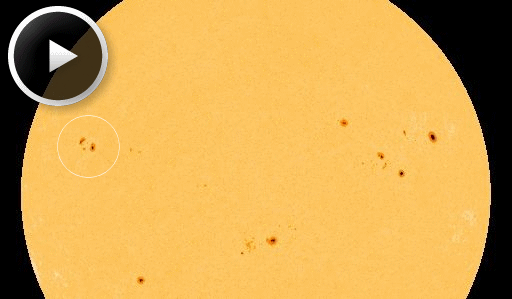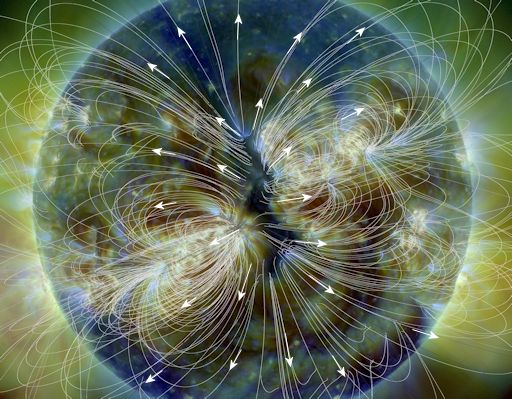When is the best time to see auroras? Where is the best place to go? And how do you photograph them? These questions and more are answered in a new book, Northern Lights - a Guide, by Pal Brekke & Fredrik Broms. | | | FULL FLOWER MOON:There's a full Moon tonight and according to folklore it has a special name: the Flower Moon. In the northern hemisphere, spring flowers are abundant in May, and the full Moon illuminates them beautifully after sunset. Take a look! [photo gallery] RAPIDLY GROWING SUNSPOT: A new sunspot is emerging in the sun's northern hemisphere. In less than a single day, the unnumbered active region has swollen from a barely-visible speck to a double-cored active region five times wider than Earth. Click to view the rapid developments: 
The new sunspot is growing so rapidly that its magnetic field is unstable. The region's magnetic canopy is crackling with C-class solar flares, including a bright C8-flare photographed by Andy Devey of southern Spain. Stronger flares could be in the offing if developments continue apace. Check back soon for updates. Realtime Space Weather Photo Gallery CORONAL CANYON: Today, the sun's atmosphere is split down the middle by a canyon-shaped coronal hole. NASA's Solar Dynamics Observatory photographed the chasm, which is almost directly facing Earth: 
Coronal holes are places where the sun's magnetic field opens up and allows solar wind to escape. This hole is straddling the sun's equator so the solar wind stream emerging from it will intersect Earth's orbit. ETA: May 16-17. High-latitude sky watchers should be alert for auroras on those dates. Aurora alerts: text, voice Realtime Aurora Photo Gallery
Realtime Mars Photo Gallery
Realtime Comet Photo Gallery Every night, a network of NASA all-sky cameras scans the skies above the United States for meteoritic fireballs. Automated software maintained by NASA's Meteoroid Environment Office calculates their orbits, velocity, penetration depth in Earth's atmosphere and many other characteristics. Daily results are presented here on Spaceweather.com. On May. 13, 2014, the network reported 62 fireballs.
(5 sporadics, 1 eta Lyrid, 1 eta Aquariid) 
In this diagram of the inner solar system, all of the fireball orbits intersect at a single point--Earth. The orbits are color-coded by velocity, from slow (red) to fast (blue). [Larger image] [movies]
Potentially Hazardous Asteroids ( PHAs) are space rocks larger than approximately 100m that can come closer to Earth than 0.05 AU. None of the known PHAs is on a collision course with our planet, although astronomers are finding new ones all the time. On May 14, 2014 there were potentially hazardous asteroids. Notes: LD means "Lunar Distance." 1 LD = 384,401 km, the distance between Earth and the Moon. 1 LD also equals 0.00256 AU. MAG is the visual magnitude of the asteroid on the date of closest approach. | | The official U.S. government space weather bureau | | | The first place to look for information about sundogs, pillars, rainbows and related phenomena. | | | Researchers call it a "Hubble for the sun." SDO is the most advanced solar observatory ever. | | | 3D views of the sun from NASA's Solar and Terrestrial Relations Observatory | | | Realtime and archival images of the Sun from SOHO. | | | from the NOAA Space Environment Center | | | the underlying science of space weather | | 
